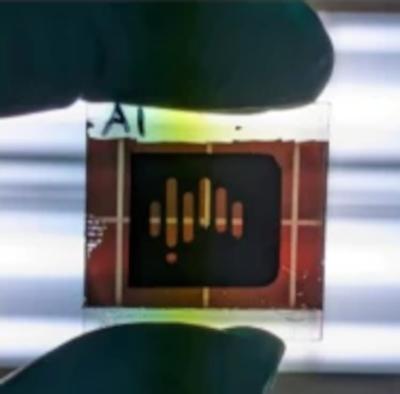Researchers from Australia's Monash University and CSIRO Manufacturing have reported a lamination technique, known as cold isostatic pressing (CIP), to build a perovskite solar cell based on a flexible bilayer electrode made of carbon and silver. The resulting electrode can reportedly compete with gold-carbon electrode based counterparts in terms of efficiency and stability.
The back side of a C-PSC with a custom-designed electrode after CIP processing. Image credit: Communications Materials
The researchers, led by CSIRO Manufacturing, which is part of Australia's Commonwealth Scientific and Industrial Research Organization (CSIRO), explained that while perovskite solar cells (PSCs) with evaporated gold (Au) electrodes have shown promising efficiencies, the maturity of the technology still demands low-cost and scalable alternatives to progress towards commercialization. Carbon electrode-based PSCs (C-PSCs) represent a promising alternative, however, optimizing the interface between the hole transport layer (HTL) and the carbon electrode without damaging the underlying functional layers is a persistent challenge, which the team set out to address.
Cold isostatic pressing (CIP) is often used to compress different types of powders for the shaping of components and semi-finished parts. It applies an isostatic pressure to a powder sample in all directions and is known for producing high-integrity semi-finished products that show little distortion or cracking when fired.
“CIP involves submerging a sample into a chamber of ambient-temperature fluid, either liquid or gas, which is then isostatically pressurized,” the scientists explained. “The CIP lamination technique is shown to apply very high mechanical pressure (up to 380 MPa) to form a seamless physical connection between the hole transport layer (HTL) and carbon film, without damaging the device, without heat and without the need for additional morphology modifications to the carbon film.”
The 60 µm electrode was coated with a 20 µm silver layer and submerged in a water-filled CIP chamber at the set pressure for 30 s and this process, according to the research group could form a strong bond between the carbon layer and the HTL. “When the CIP pressure was applied, the thickness, morphology and conductivity of the coated electrode films were altered,” it explained. “Following the application of pressure, both films were compressed, with the Ag film reducing to around 16 µm and the carbon film reducing to around 40 µm.”
The scientists built the cell with a glass-coated indium tin oxide (ITO) substrate, an electron transport layer (ETL) based on either tin oxide (SnO2), a perovskite absorber, an HTL relying on Spiro-OMeTAD, and the carbon-silver contact.
Tested under standard illumination conditions, the device achieved a power conversion efficiency of 20.8%, an open-circuit voltage of 1.10 V, a short-circuit current density of 23.2 mA/cm2, and a fill factor of 81.3%. These results, the scientists said, are in line with those of reference devices built with more expensive, evaporated gold (Au) electrodes.
“The extreme pressure was combined with the benefits of a coated bilayer electrode consisting of carbon for soft interface contact and silver for high conductivity,” they explained. “Therefore, performance loss was minimized for large-area carbon perovskite solar cells, with record efficiencies of 19.8% and 16.9% for cell areas of 0.95 cm2 and 5.5 cm2, respectively.”
“These findings underscore the critical role of interface contact in enhancing carbon perovskite cell performance, and the results pave the way for developing low-cost, efficient, and reliable perovskite solar cells,” the researchers concluded.




